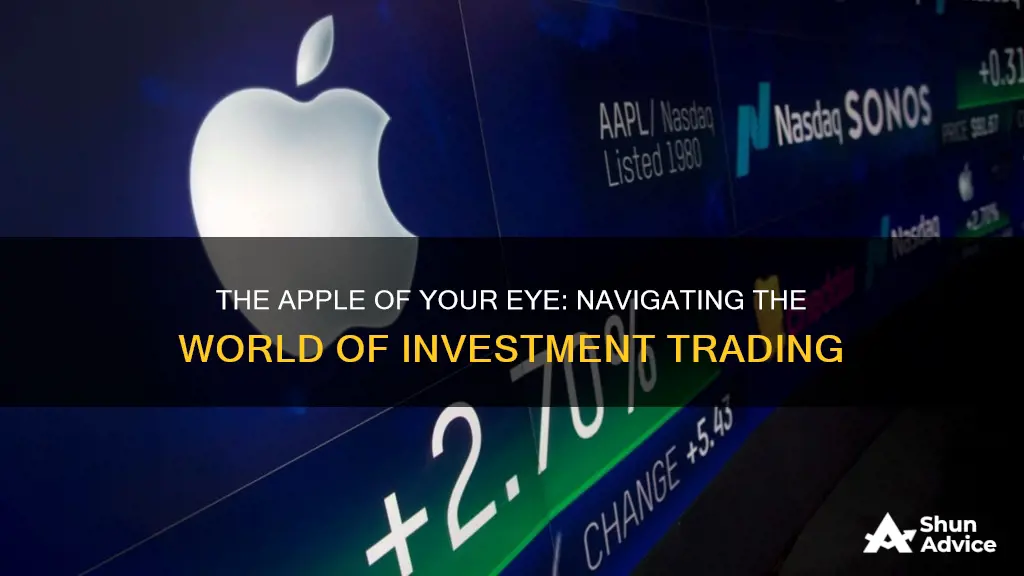
Apple is a publicly traded company on the NASDAQ stock exchange under the ticker symbol AAPL. The company has been publicly traded since December 12, 1980, and its stock can be purchased through any brokerage or trading app.
Before buying Apple stock, it is important to conduct thorough research into the company's fundamentals, including its revenue, net income, and earnings. It is also crucial to review your investment portfolio and set a budget to determine how much Apple stock you can afford to buy.
When you are ready to purchase Apple stock, you can place a market order or a limit order through your chosen brokerage platform. A market order is executed immediately at the best available market price, while a limit order allows you to set a specific price at which you want to buy the stock.
It is worth noting that investing in stocks carries inherent risks, and it is recommended to consult with a financial advisor before making any investment decisions.
What You'll Learn

Research Apple's fundamentals
Apple Inc. is a highly profitable company that engages in the design, manufacture, and sale of smartphones, personal computers, tablets, wearables, accessories, and related services. The company was founded in the 1970s by Steve Jobs, Steve Wozniak, and Ronald Wayne, and it has since grown and expanded its product line to include input devices, output devices, storage devices, computers, and connecting devices.
When researching Apple's fundamentals, it is important to consider various financial indicators and metrics. Here is an overview of some key areas to focus on:
Financial Statements and Ratios
Analyse Apple's income statements, balance sheets, and cash flow statements. Examine patterns and changes in revenue, net income, cash flow, and growth rates. Also, look at financial ratios such as P/E ratio, P/S ratio, ROE, ROA, ROIC, gross margin, operating margin, and net margin.
Market Position and Competition
Compare Apple's current valuation, growth rates, and financial ratios with those of its competitors and the industry averages. This will help determine if Apple is overvalued or undervalued relative to its peers.
Business Activities and Performance
Understand Apple's primary business activities, including its product lines, services, and customer segments. Evaluate the company's performance by looking at metrics such as revenue growth, net income growth, profitability, and market share.
Insider Trading and Analyst Opinions
Monitor insider trading activities and keep track of analyst opinions and predictions. This can provide insights into the company's future prospects and expected earnings.
ESG (Environmental, Social, and Governance) Factors
Consider Apple's sustainability indicators and how they impact investment strategies. Studies suggest that companies with high sustainability scores tend to receive higher valuations.
Investment Opportunities and Risks
Assess Apple's investment opportunities by analysing its competitive position, market share, product uniqueness, and competitive advantages. Also, be mindful of potential risks and challenges the company may face in the near future.
By thoroughly researching these fundamentals, you can gain a deeper understanding of Apple's financial health, performance, and potential investment opportunities.
Training Investments: Why Bother?
You may want to see also

Consider whether to buy Apple stock
Before buying Apple stock, you should consider researching the company's fundamentals, reviewing your portfolio, and setting a budget. Here are some key points to think about:
- Research the fundamentals of Apple stock: Look at both quantitative research (revenue, net income, and earnings) and qualitative research (competition, management, and business model). Review Apple's annual and quarterly reports, which provide key information on the company's operations, financial results, sources of income, and expenses. Also, consider factors such as the price-to-earnings ratio, dividend yield, and growth rate.
- Evaluate your investment portfolio: Investing is about diversification and asset allocation. Consider how Apple stock fits into your existing portfolio and whether it aligns with your risk tolerance. Assess if buying Apple stock shifts your portfolio too heavily towards technology stocks or stocks in general. Remember that investing your entire portfolio in a single stock is considered risky.
- Decide how much to invest: Determine how the investment amount will affect your portfolio balance. Generally, it's recommended to have no more than 10% of your total portfolio in one stock. Consider your short-term goals, future investment plans, and emergency funds before deciding on the investment amount.
- Understand the risks and potential rewards: Apple stock has been a winning investment over the long term, but it's important to remember that past performance doesn't guarantee future results. Evaluate the risks and potential rewards based on your financial situation, current holdings, and investment goals.
- Stay informed about Apple's performance and news: Keep up with Apple's financial health, product launches, and market trends. Stay informed about factors that could impact Apple's stock price, such as competition, regulatory scrutiny, and economic conditions.
- Seek independent financial advice: Consult a financial advisor or a certified financial planner to get personalised advice based on your unique circumstances. They can provide valuable insights and help you make an informed decision about investing in Apple stock.
Monthly Cash Flow: Exploring Regular-Income Investments
You may want to see also

Decide how much to invest
How much you can afford to invest depends on your personal financial situation. You should only invest money that you can afford to lose, and that you won't need in the short term. It's recommended that you have enough savings to cover three to six months' worth of living expenses before investing.
You should also consider how investing in Apple stock will affect the balance of your portfolio. It's generally recommended that no more than 10% of your total portfolio should be invested in a single stock.
If you're investing in Apple, you may want to opt for a brokerage that allows you to buy fractional shares, which are portions of a share at a lower price. This can be a good option if you don't want to commit to purchasing a whole share of Apple stock.
You should also think about your future investment plans. Dollar-cost averaging is a strategy where you invest regular, fixed amounts over time, rather than a lump sum all at once. This can help to reduce your risk and ensure you don't buy all your stock when prices are high.
If you're investing in Apple, you'll need to consider how much money you have available to invest, how this will affect the balance of your portfolio, and whether you want to invest a lump sum or use a dollar-cost averaging strategy.
The Retirement Dilemma: Pay Off Debt or Invest?
You may want to see also

Open a brokerage account
Opening a brokerage account is the first step to buying stocks, bonds, mutual funds, and other investments. You can open a brokerage account in about 15 minutes, and the process is similar to signing up for a checking or savings account.
To open a brokerage account, you'll need to provide some personal information, such as your Social Security number, address, phone number, and email address. You may also need to provide a copy of your driver's license or passport to verify your identification.
When choosing a brokerage, consider factors such as the breadth of additional investments offered, customer service, and the tools and resources available to help you with your investing journey. Look for low or no commissions and consider whether the broker offers fractional shares, which allow you to invest in stocks with a small amount of money.
Once you've chosen a brokerage, follow the instructions on their website or app to set up your account. Be sure to read through the terms and conditions carefully before making any investments.
With a brokerage account, you can start investing in Apple and other companies, building a diverse portfolio that aligns with your risk tolerance and investment goals.
Renewable Energy's Return: Does Green Energy Pay Dividends?
You may want to see also

Place your order
Once you've decided how much Apple stock you want to buy, it's time to place your order. You can do this through your chosen brokerage's platform.
There are two common types of orders: market orders and limit orders. A market order is executed as soon as possible at the best available market price at the time. This is a good option for buy-and-hold investors, as it guarantees you buy shares immediately, although you may not get the exact price you see when placing your order. A limit order, on the other hand, allows you to set a specific price at which you wish to buy. This gives you more control, but your trade may not be executed if the stock never hits your desired price.
Apple is traded on the Nasdaq exchange, so it can be bought or sold between 9:30 a.m. and 4:00 p.m. ET Monday through Friday. The Nasdaq also has pre-market and after-hours trading, which you may be able to access through your brokerage. Pre-market trading hours are 4:00 a.m. until 9:30 a.m., and after-hours trading runs from 4:00 p.m. until 8:00 p.m. ET. If you place an order outside of your brokerage's trading hours, it will be processed once trading resumes.
Invest: Picking the Right Neighborhood
You may want to see also
Frequently asked questions
You can buy Apple stocks through any brokerage or trading app. You'll need to search for Apple using the symbol "AAPL". You cannot buy Apple stock directly from Apple.
There are two basic types of orders: market and limit orders. A market order is executed ASAP at the best available market price at the time. A limit order is executed at a specific price set by the investor.
AAPL.
Apple is currently the largest and most valuable company worldwide, with a market cap of $2729.79 billion. Its price-to-earnings ratio is 29.47.
Pros:
- Apple has enormous cash on hand ($55.872 billion as of March 2023)
- Apple has been increasing its annual dividend payouts since 2012
- Apple is constantly expanding its products and services
Cons:
- Apple faces growing competition from Samsung, Google, and Huawei
- iPhone sales are declining in the global market share
Some alternatives to buying Apple stocks are Microsoft (NASDAQ: MSFT) and Alphabet (NASDAQ:GOOGL).







